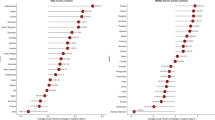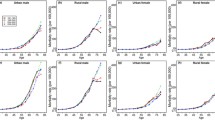Abstract
A number of hypotheses have been advanced to explain the rapid increase of the incidence of esophageal adenocarcinoma in the US. A major problem in identifying and understanding the nature of this increase is the difficulty in untangling age effects from temporal trends due to cohort and period effects. To address this problem, we have developed multi-stage carcinogenesis models that describe the age-specific incidence of adenocarcinoma of the esophagus and of the gastric cardia with separate adjustments for temporal trends. These models explicitly incorporate important features of the cancers, such as the metaplastic conversion of normal esophagus to Barrett’s esophagus (BE). We fit these models separately to the incidence of adenocarcinoma of the esophagus and of the gastric cardia reported in the Surveillance Epidemiology and End Results (SEER) registry over the period 1973–2000. We conclude that the incidence of both cancers is consistent with a sequence that posits a tissue conversion step in the target organ followed by a multi-stage process with three rate-limiting events, the first two leading to an initiated cell that can expand clonally into a premalignant lesion, and the third converting an initiated cell into a malignant cell. Temporal trends in the incidence of both cancers are dominated by dramatically increasing period effects.





Similar content being viewed by others
Notes
C. Maley, personal communication.
BRFSS: Behavioral Risk Factor Surveillance System, 1990–2000 Prevalence of Obesity Among U.S. Adults by state (BRFSS (1990–2000); self-reported data). Internet address: http://www.cdc.gov/nccdphp/dnpa/obesity/trend/prev_reg.htm.
T.L. Vaughan, personal communication.
References
Bollschweiler E, Wolfgarten E, Gutschow C, Holscher AH (2001) Demographic variations in the rising incidence of esophageal adenocarcinoma in white males. Cancer 92:549–555
Botterweck AA, Schouten LJ, Volovics A, Dorant E, van Den Brandt PA (2000) Trends in incidence of adenocarcinoma of the oesophagus and gastric cardia in ten European countries. Int J Epidemiol 29:645–654
Devesa SS, Blot WJ, Fraumeni JF Jr (1998) Changing patterns in the incidence of esophageal and gastric carcinoma in the United States. Cancer 83:2049–2053
El-Serag HB, Mason AC, Petersen N, Key CR (2002) Epidemiological differences between adenocarcinoma of the oesophagus and adenocarcinoma of the gastric cardia in the USA. Gut 50:368–372
Eloubeidi MA, Mason AC, Desmond RA, El-Serag HB (2003) Temporal trends (1973–1997) in survival of patients with esophageal adenocarcinoma in the United States: a glimmer of hope? Am J Gastroenterol 98:1627–1633
Nguyen AM, Luke CG, Roder D (2003) Comparative epidemiological characteristics of oesophageal adenocarcinoma and other cancers of the oesophagus and gastric cardia. Asian Pac J Cancer Prev 4:225–231
Vizcaino AP, Moreno V, Lambert R, Parkin DM (2002) Time trends incidence of both major histologic types of esophageal carcinomas in selected countries, 1973–1995. Int J Cancer 99:860–868
Younes M, Henson DE, Ertan A, Miller CC (2002) Incidence and survival trends of esophageal carcinoma in the United States: racial and gender differences by histological type. Scand J Gastroenterol 37:1359–1365
Vaughan TL (2002) Esophagus. In: Franco EL, Rohan TE (eds) Cancer precursors. Springer-Verlag New York, Inc., pp 69–116
Cameron AJ (2001) The history of Barrett esophagus. Mayo Clin Proc 76:94–96
Kim R, Weissfeld JL, Reynolds JC, Kuller LH (1997) Etiology of Barrett’s metaplasia and esophageal adenocarcinoma. Cancer Epidemiol Biomarkers Prev 6:369–377
Ramel S (2003) Barrett’s esophagus:model of neoplastic progression. World J Surg 27:1009–1013
Reid BJ (1991) Barrett’s esophagus and esophageal adenocarcinoma. Gastroenterol Clin N Am 20:817–834
Shaheen N, Ransohoff DF (2002) Gastroesophageal reflux, Barrett esophagus, and esophageal cancer: clinical applications. JAMA 287:1972–1981
Vaughan TL, Kristal AR, Blount PL, et al (2002) Nonsteroidal anti-inflammatory drug use, body mass index, and anthropometry in relation to genetic and flow cytometric abnormalities in Barrett’s esophagus. Cancer Epidemiol Biomarkers Prev 11:745–752
Whittles CE, Biddlestone LR, Burton A, et al (1999) Apoptotic and proliferative activity in the neoplastic progression of Barrett’s oesophagus:a comparative study. J Pathol 187:535–540
Wild CP, Hardie LJ (2003) Reflux, Barrett’s oesophagus and adenocarcinoma: burning questions. Nat Rev Cancer 3:676–684
Cameron AJ, Zinsmeister AR, Ballard DJ, Carney JA (1990) Prevalence of columnar-lined (Barrett’s) esophagus. Comparison of population-based clinical and autopsy findings. Gastroenterology 99:918–922
Wang LD, Zheng S, Zheng ZY, Casson AG (2003) Primary adenocarcinomas of lower esophagus, esophagogastric junction and gastric cardia: in special reference to China. World J Gastroenterol 9:1156–1164
Powell J, McConkey CC, Gillison EW, Spychal RT (2002) Continuing rising trend in oesophageal adenocarcinoma. Int J Cancer 102:422–427
Wijnhoven BP, Siersema PD, Hop WC, van Dekken H, Tilanus HW (1999) Adenocarcinomas of the distal oesophagus and gastric cardia are one clinical entity. Rotterdam Oesophageal Tumour Study Group. Br J Surg 86:529–535
Corley DA, Buffler PA (2001) Oesophageal and gastric cardia adenocarcinomas: analysis of regional variation using the cancer incidence in five continents database. Int J Epidemiol 30:1415–1425
Surveillance, Epidemiology, and End Results (SEER) Program (http://www.seer.cancer.gov) SEER*Stat Database:Incidence – SEER Regs Public-Use, Nov 2002 Sub (1973–2000), National Cancer Institute, DCCPS, Surveillance Research Program, Cancer Statistics Branch, released April 2003, based on the November 2002 submission
Holford TR (1991) Understanding the effects of age, period, and cohort on incidence and mortality rates. Annu Rev Public Health 12:425–457
Kupper LL, Janis JM, Karmous A, Greenberg BG (1985) Statistical age–period–cohort analysis: a review and critique. J Chronic Dis 38:811–830
Zheng T, Mayne ST, Holford TR, et al (1992) Time trend and age–period–cohort effects on incidence of esophageal cancer in Connecticut, 1935–89. Cancer Causes Control 3:481–492
Clayton D, Schifflers E (1987) Models for temporal variation in cancer rates. I: Age–period and age–cohort models. Stat Med 6:449–467
Holford TR (1992) Analysing the temporal effects of age, period and cohort. Stat Methods Med Res 1:317–337
Luebeck EG, Moolgavkar SH (2002) Multistage carcinogenesis and the incidence of colorectal cancer. Proc Natl Acad Sci USA 99:15095–15100
Cameron AJ, Lomboy CT (1992) Barrett’s esophagus: age, prevalence, and extent of columnar epithelium. Gastroenterology 103:1241–1245
Wong DJ, Paulson TG, Prevo LJ, et al (2001) p16(INK4a) lesions are common, early abnormalities that undergo clonal expansion in Barrett’s metaplastic epithelium. Cancer Res 61:8284–8289
Maley CC, Galipeau PC, Li X, Sanchez CA, Paulson TG, Reid BJ (2004) Selectively advantageous mutations and hitchhikers in neoplasms: p16 lesions are selected in Barrett’s esophagus. Cancer Res 64:3414–3427
Heidenreich WF, Luebeck EG, Moolgavkar SH (1997) Some properties of the hazard function of the two-mutation clonal expansion model. Risk Anal 17:391–399
Mayne ST, Navarro SA (2002) Diet, obesity and reflux in the etiology of adenocarcinomas of the esophagus and gastric cardia in humans. J Nutr 132:3467S–3470S
Haggitt RC (1994) Barrett’s esophagus, dysplasia, and adenocarcinoma. Hum Pathol 25:982–993
Herbst JJ, Berenson MM, McCloskey DW, Wiser WC (1978) Cell proliferation in esophageal columnar epithelium (Barrett’s esophagus). Gastroenterology 75:683–687
Uys P, van Helden PD (2003) On the nature of genetic changes required for the development of esophageal cancer. Mol Carcinog 36:82–89
Maley CC, Galipeau PC, Li X, et al (2004) The combination of genetic instability and clonal expansion predicts progression to esophageal adenocarcinoma. Cancer Res 64:7629–7633
Cameron AJ, Arora AS (2002) Barrett’s esophagus and reflux esophagitis: is there a missing link? Am J Gastroenterol 97:273–278
Farrow DC, Vaughan TL, Sweeney C et al (2000) Gastroesophageal reflux disease, use of H2 receptor antagonists, and risk of esophageal and gastric cancer. Cancer Causes Control 11:231–238
Cameron AJ (2002) Epidemiology of Barrett’s esophagus and adenocarcinoma. Dis Esophagus 15:106–108
Pohl H, Welch HG (2005) The role of overdiagnosis and reclassification in the marked increase of esophageal adenocarcinoma incidence. J Natl Cancer Inst 97:142–146
Lagergren J (2005) Adenocarcinoma of oesophagus: what exactly is the size of the problem and who is at risk? Gut 54(Suppl 1):1–5
Engel LS, Chow W, Vaughan TL, et al (2003) Population attributable risks of esophageal and gastric cancers. J Natl Cancer Inst 95:1404–1413
Cameron AJ, Welborn TA, Zimmet PZ, et al (2003) Overweight and obesity in Australia:the 1999–2000 Australian Diabetes, Obesity and Lifestyle Study (AusDiab). Med J Aust 178:427–432
La Vecchia C, Negri E, Lagiou P, Trichopoulos D (2002) Oesophageal adenocarcinoma: a paradigm of mechanical carcinogenesis? Int J Cancer 102:269–270
Barrett MT, Sanchez CA, Prevo LJ, et al (1999) Evolution of neoplastic cell lineages in Barrett oesophagus. Nat Genet 22:106–109
Maley CC, Galipeau PC, Li X, Sanchez CA, Paulson TG, Reid BJ (2004) Selectively advantageous mutations and hitchhikers in neoplasms: p16 lesions are selected in Barrett’s esophagus. Cancer Res 64:3414–3427
Shaheen NJ, Inadomi JM, Overholt BF, Sharma P (2004) What is the best management strategy for high grade dysplasia in Barrett’s oesophagus? A cost effectiveness analysis. Gut 53:1736–1744
Spechler SJ, Barr H (2004) Review article: screening and surveillance of Barrett’s oesophagus: what is a cost-effective framework? Aliment Pharmacol Ther 19(Suppl 1):49–53
Vaughan TL, Dong LM, Blount PL, et al (2005) Non-steroidal anti-inflammatory drugs and risk of neoplastic progression in Barrett’s oesophagus: a prospective study. Lancet Oncol 6:945–952
Acknowledgments
This study was supported by NIH grant RO1 CA047658, and RO1 CA119224-01. We also would like to thank Dr. Carlo Maley (Wistar Institute) for helpful discussions.
Author information
Authors and Affiliations
Corresponding author
Appendix
Appendix
BE/multi-stage clonal expansion model
We briefly summarize the mathematical development for the model depicted in Fig. 2. The model consists of two parts: the random occurrence of BE in the population, and the multi-stage carcinogenesis process arising in BE. Thus we derive the hazard function for the composition model of two random processes: tissue conversion from normal esophagus to BE, and multi-stage carcinogenesis process after onset of BE. The probability density function (pdf) for our model is defined by
where f BE and f MS are the pdfs of tissue conversion process and MSCE model, respectively, in Fig. 2. Let T be a random variable of appearance time of a malignant tumor, and let
The hazard function h(t) is defined by
The survival function S(t) is obtained by
Thus the hazard function h(t) is the following:
where S MS is the survival function for MSCE model in Fig. 2. Note that f(t)=−S′(t) and thus f(t)=h(t)S(t). Since \(h(t)=-{\partial}/{\partial t} \hbox{ln} S(t)\), we have the following equation:
Since we assume that the age to onset of BE follows an exponential distribution with rate ν, f BE(u)=ν e−ν u. For the details about h MS and S MS, refer to [29]. Let X be the number of stem cells in BE, and α and β be the cell division rate and the cell differentiation/death rate of an initiated stem cell, respectively. For k=3 in Fig. 2, which was considered as the best model in our study, the hazard function is given by (5) below.
and p and q are given by
Rights and permissions
About this article
Cite this article
Jeon, J., Luebeck, E.G. & Moolgavkar, S.H. Age effects and temporal trends in adenocarcinoma of the esophagus and gastric cardia (United States). Cancer Causes Control 17, 971–981 (2006). https://doi.org/10.1007/s10552-006-0037-3
Received:
Accepted:
Issue Date:
DOI: https://doi.org/10.1007/s10552-006-0037-3




